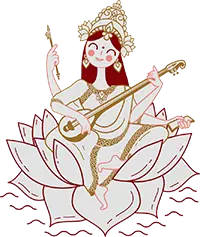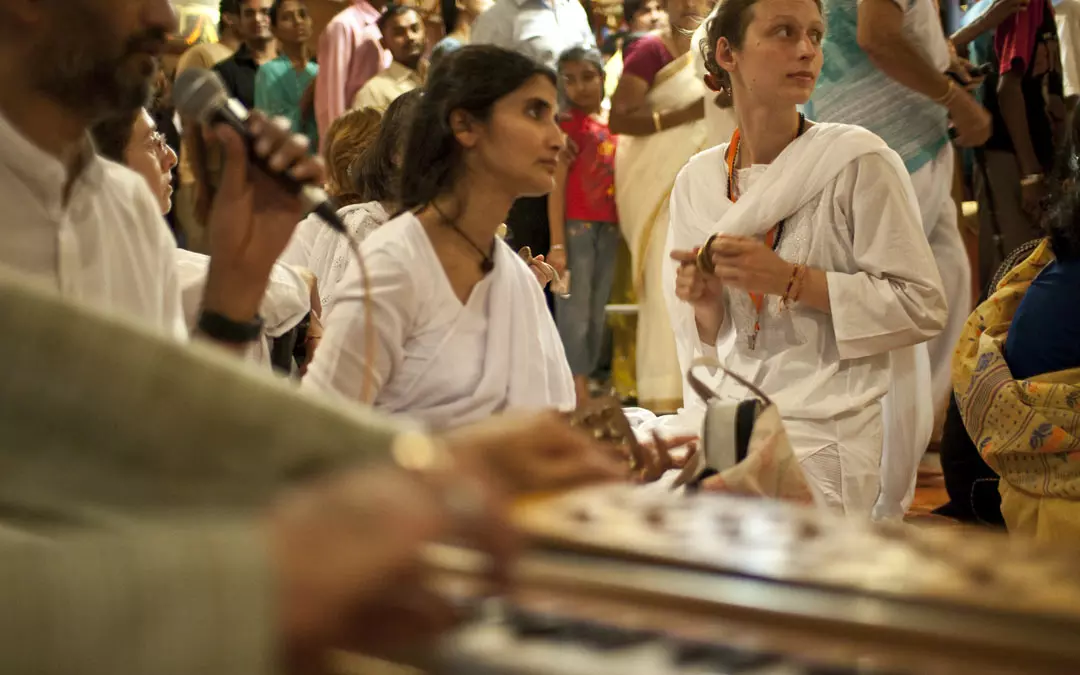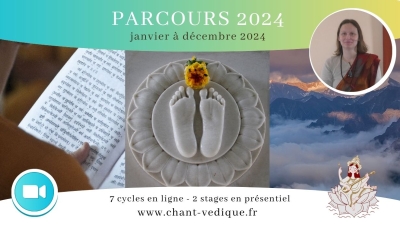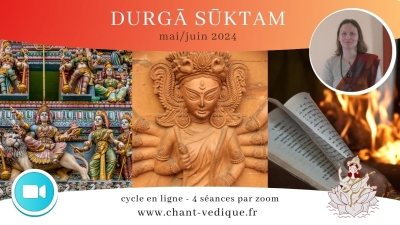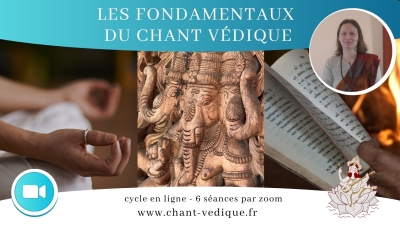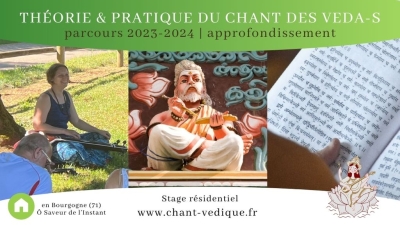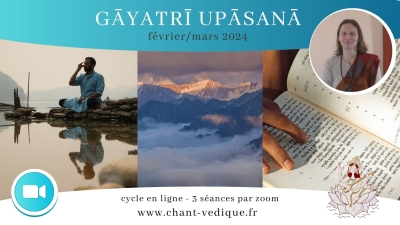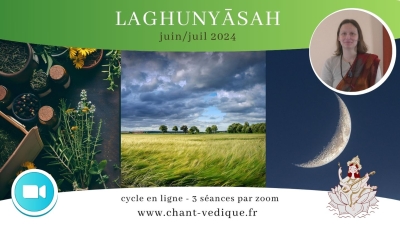ITW Indica Yoga - Conversations
by Sophia French
february 2023
february 2023
You were drawn to mantras and sound while travelling in India? Can you tell us about the experience and how it shaped your spiritual path?
I heard the first mantras in France. We were having kirtans while studying in our yoga school. It was a beautiful introduction. On the first travel to India, I was completely mesmerized by the chanting of the priests in the temples and devotional kirtans in the ashrams. I was going from ashram to temples and temples to ashrams. It was really meditative and those chantings were bringing inner silence where outwardly it was complete apparent chaos.
Then the next year, while I was working full time for the spiritual center where I was following my yoga training and I was asked to make a documentary for the yoga school on Indian spirituality in the ashrams we were connected with. I went with a group of sadhaka at Chinmaya mission in Mumbai the week before Shivaratri. The whole week was dedicated to the preparation of this special event through teaching and all kind of rituals (puja, yajña, abhisheka, manasa puja etc…). About a hundred Indians were there to attend the camp and thousands came to the Shiva Temple for the night of Shivaratri. The more I was filming the more I was withdrawing in myself. As if the lens of the camera took the whole space of my consciousness. “I” wasn’t filming anymore, the mind was completely quiet, just going with the flow of the rituals, hearing deeply the mantras. That’s where I connected with the sense of inner yajña, where offering made outwardly are really made to the divine withing us. I was that fire, I was the one offering, I was the one receiving, it was pure ananda. Abhishekam was refreshing the lingam of my burning Heart. I understood that what I took as poetry in the scripture, was actually the living experience of the teachers that were expressing it. From that moment I was really drown to devotional practices. Putting down my camera and back home, I was a lot reciting or singing mantras, entering into this devotional path and burning on the fire of Yoga.
What drew you to the teachings of Ramana Maharshi ?
Our yoga school had connection with many ashrams and different lineages in India and for several years I had the great chance to hear great Masters such as Swami Tejomayananda and Swamini Umananda from Chinmaya Mission, Chandra Swami Udasin, Swami Atmananda, Swami Muktananda from Divine life society, Swami Nirgunananda close disciple of Ma Ananadamayi, Ma Amritanandamayi and french sadhakas who were deeply committed in their sadhana in one lineage or another. My whole life was revolving around yoga, I was living like a monk and working for spiritual center. But at some point, I felt completely desperate. I was longing so much for this divine realisation, that I just gave up. I told to myself : “If I am never meant to find what all this great masters talk about, so be it !”. And I was to take a group of yoga students to India the week after. We took off to India to several ashrams and on the way we had a stop at Arunachala’s feet and at Ramana Ashram. We met a teacher at Arunachala’s feet and after a satsang I found myself unable to chant anymore or to do any kind of practice as if it would drive me away from what I was really looking for. It was deeply disturbing, because practices were the only way I knew to connect to the divine. I spent the next couple of years attending non-dual satsangs to understand the state I was left in, getting slowly to understand Ramana’s teaching and what was self-inquiry about. Then back to Arunachala, I met Shri Nochur Venkataramam who regularly exposes Ramana’s teaching with clarity and devotion and who ever since has been my source of inspiration to listen to the “voice of the rishis”.
What is vocal yoga and how do you practise it ?
Vocal yoga is the combination of Indian Classical Music and Kirtans. The practice was structured by a French couple, Adam S. Callejon and Nathalie Nichanian.
He was a musician and also a disciple of Barun Kumar Pal and she was a yoga teacher.
They both learnt Dhrupad from Yvan Trunzler, who was a disciple of the Dagar brothers.
They structured a method oriented to anyone unable to spend a decades at the feet of a music master in India so it would still be possible to benefit from the power of sound through ragas and the potency of mantras.
Vocal Yoga is a meditative sound focusing practice where you turn your attention inward to feel the vibration of the sound, to connect with its subtlety. Your mind comes to rest in your Heart in some wider consciousness where you experience the beauty of the energy field created by the scale and movement of a raga. And then comes a time for kirtan.
The musical arrangement or composition are created by Adam in accordance to the structure of the raga. Thus everything we chant during the kirtan benefits from both Sanskrit words and raga field. Then ultimately everything resolve in Silence where you can just let anything that happened during the chant be integrated.
The practice is deeply harmonising, it is a beautiful way to connect with the power of sound, to connect to the divine and ultimately to yourself.
I practice it as an offering to the divine. For me it is an expression of devotion, like some inner puja where sound becomes my ghee, my flowers, my incense. It is a beautiful way to outpour love and devotion and to rest in the Heart. It is also an amazing way to connect to the underlying Silence which is always here no matter what we are chanting or experiencing. Then you are taught by sounds, it becomes a mirror of understanding.
What does spirituality mean to you in the context of Indian knowledge systems ?
I would say spirituality is the ultimate goal and path of life. Indian Knowledge System would refer for me to any teaching who can express the beauty of the vedas in its own language, should it be art, music, astrology, astronomy, mathematics... IKS is a medium though which a shift in our perception and understanding of the world and of ourselves can happen, and in that sense spirituality disappears when you can see through your Heart. Then it is just life unfolding itself.
What was it like studying chanting with Shatala Sriramaiahji ?
What are some of your favourite mantras and why?
Shantala’s classes are pure blessings. She is like Annapurna feeding us with mantras and words with so much love and generosity. She makes accessible the beauty of vedic chanting. Without her, not being born and grewn up in Indian family, we wouldn’t be able to learn the Vedas in that way. Through her classes, it is like she opens her arms and welcome us in her family, in her culture, in her sampradaya. Thanks to her, we are walking the path of the rishis, chanting and learning the vedas, their deeper meaning, connecting with the forces outside and within ourselves.
That would be really hard to choose some specific mantras. Each of them is like a piece of a crystal you wouldn’t like to break it apart. That is why, anything she would teach I’ll be there ! Being able to discover some more facets of this life wonder in so much gratitude.
How do you find Indian spirituality different from Western systems, and can both learn from each other ?
I don’t intimately know any other spiritual system. But the spiritual center I was working in, was organising really big congresses with spiritual leaders and mystics coming from all other the world from different traditions. What I understood from their sharings is that spirituality is what makes the universal chore of all religions. Spirituality is what unites us. There were Catholics, Hindus, Muslims, Orthodox … monks or household teachers and they were all expressing the same wisdom. Each one of us is walking its own path, with sincerity, and we need to go behind the words and the forms to be able to recognise this unity. We need to learn to silent our mind and to hear with our Heart whatever practice or path suits to our upbringing and mind disposition.
What are some of your favourite books on spirituality ?
Any mystic’s biography is a jewel of inspiration and a source of divine contagion.
Any book, written by someone who really lives his words is an inspiration.
Still my favourite book is “Talks on Adi Shankaracharya’s Dakshinamurti Stava by shri Nochur Venkataraman. It is a commentary on Dakshinamurti’s stotram. Dakshnimurti is the embodiment of the Silent teacher and the ultimate guru who transmits his teaching heart to heart through the power of grace. Reading, chanting, honoring his name is a way to express our gratitude to all the teachers we meet on our path.
